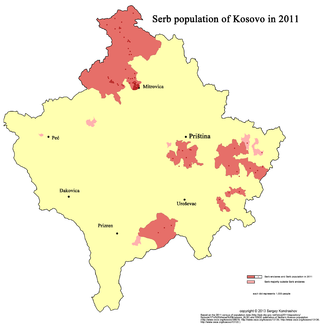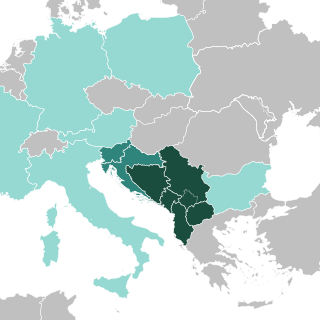Related Research Articles

Serb enclaves are settlements in Kosovo outside North Kosovo where Serbs form a majority.

Novo Brdo or Novobërda and Artanë, is a town and municipality located in the Prishtina district of Kosovo. According to the 2011 census, it has a population of 6,729 inhabitants. The center of the municipality is the village of Bostane. The region is especially known for its role in mining during medieval times, in particular after the construction of the Novo Brdo Fortress by Stefan Milutin to house Saxon miners who were brought in the region.
Labudovo Brdo is an urban neighborhood of Belgrade, the capital of Serbia. It is located in Belgrade's municipality of Rakovica.

The District of Prishtina is a district in Kosovo. Its seat is the capital city of Pristina. It consists of eight municipalities and 298 villages. According to the 2011 census, the total population of the district is 477,312.

Banovo Brdo is a neighbourhood of Belgrade, Serbia. It is located in Belgrade's municipality of Čukarica.

Julino Brdo is an urban neighborhood of Belgrade, the capital of Serbia. It is located in Belgrade's municipality of Čukarica.
Sunčana Padina is an urban neighborhood of Belgrade, the capital of Serbia. It is located in Belgrade's municipality of Čukarica.
Topčidersko Brdo is an urban neighborhood and former municipality of Belgrade, the capital of Serbia. It is located in Belgrade's municipality of Savski Venac.
Pašino Brdo is an urban neighborhood of Belgrade, the capital of Serbia. It is located in Belgrade's municipality of Voždovac, while the northern section belongs to the municipality of Vračar. It is also known as Lekino Brdo after the top Communist official, Aleksandar Ranković (1909–80), whose nickname was Leka.

Vinča-Belo Brdo is an archaeological site in Vinča, a suburb of Belgrade, Serbia. The tell of Belo Brdo is almost entirely made up of the remains of human settlement, and was occupied several times from the Early Neolithic through to the Middle Ages. The most substantial archaeological deposits are from the Neolithic-Chalcolithic Vinča culture, of which Vinča-Belo Brdo is the type site.
Vladislav the Grammarian was a Bulgarian Orthodox Christian monk, scribe, historian and theologian active in medieval Bulgaria and Serbia, regarded as part of both the Bulgarian and Serbian literary corpus. His collections of manuscripts constitute a compendium of translations and original Bulgarian and Serbian texts produced between the 13th and 15th centuries.

Bijelo Brdo is a village in the Erdut municipality in eastern Croatia. It is connected by the D213 road and by R202 railway. It has a total of 1,961 inhabitants (2011).
Crna Glava is a village in the municipality of Raška, Serbia. As of the 2002 census, the village has a population of 246 people. Crna Glava is one of the oldest places in Serbia and is mentioned in Žiča in "hrisovulja" from 1222.A.C. as "Čisto brdo" which is a part of today's village.
Janja Kantakouzenos was a nobleman from the mine town of Novo Brdo who had economic deals in the mining industry with the Ottoman Empire after their conquest of Serbia. He was a descendant of the Kantakouzenoi that settled in Serbia after the marriage between Despot Đurađ Branković and Irene Kantakouzene.
Martin Segon was a Serbian writer, Catholic Bishop of Ulcinj, and a notable 15th-century humanist.
The Sanjak of Viçitrina, also known as the Pristina Pashaluk, was a sanjak of the Ottoman Empire in Rumelia, in present-day Kosovo. It was named after its administrative center Vushtrri.

Novo Brdo Fortress is a medieval Serbian fortress in Kosovo. Its ruins are located near the town of Novo Brdo, about 40 kilometres (25 mi) east of Pristina. The fortress was built in the late 13th century by king Stephen Uroš II Milutin of Serbia to protect gold, silver, iron and lead mines which were abundant throughout the area. Novo Brdo was famous for its silver. Together with the castles of Prizren, 12 kilometres (7.5 mi) to the southwest, and Prilepac, 13 kilometres (8.1 mi) to the southeast, which guard access roads to the fortress, Novo Brdo helped form a defensive complex overlooking the lucrative mining operations. Novo Brdo was at its height during the Serbian Despotate (1402–1459), when it was the most important mining area and second most important town in Serbia. A significant number of Saxon miners, Albanian Catholics and a large Ragusan merchant colony lived within the town, which was ruled by a vojvoda, but also a governor (kefalija), because it was the seat of an administrative unit of the Despotate.
Demetrius Kantakouzenos was a Serbian writer of Greek origin who lived in the 15th century Serbian Despotate.

The siege of Novo Brdo was a military blockade of Novo Brdo, an important fortified mining town in the Serbian Despotate, by the forces of the Ottoman Empire. The siege began in 1440 and lasted until the capture of the fortress on 27 June 1441. During the siege, the Serbian garrison was supported by the local community of citizens of the Republic of Ragusa.

The Brdo-Brijuni Process is an annual multilateral event in the Western Balkans. It was initiated in 2013 by Slovenian president Borut Pahor and Croatian president Ivo Josipović. The first official meeting was in Brdo pri Kranju, Slovenia. The main focus of the Process is the enlargement of the European Union with countries of the Western Balkans. Similar meetings were held at the prime-ministerial level in 2010 and 2011 by then-Prime Ministers of Slovenia and Croatia, Borut Pahor and Jadranka Kosor. The Brdo-Brijuni process includes Slovenia and Croatia and candidates and potential candidates for EU membership from the Western Balkans.
References
- (in Serbian) Beograd na 29 brežuljaka